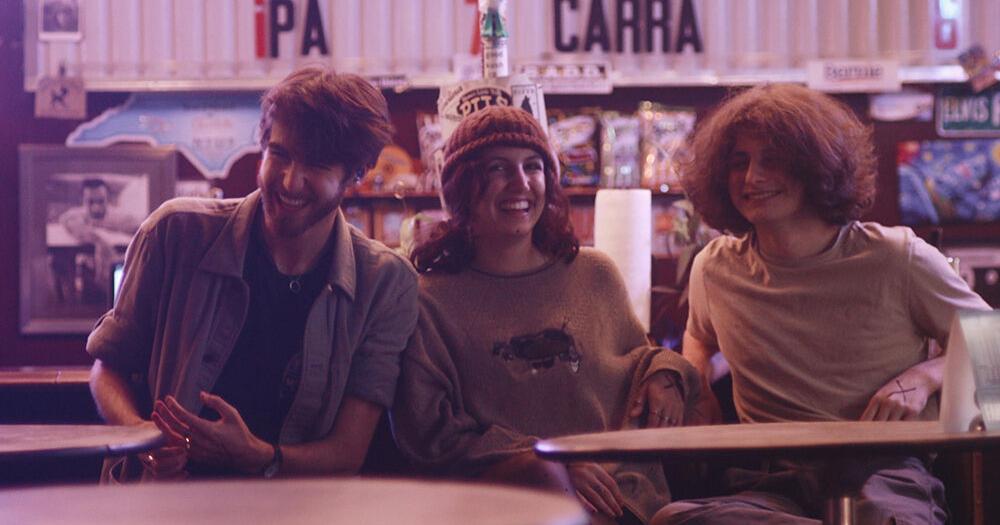Moving Boxes, a new Raleigh/Charlotte-based math rock band, are establishing themselves as a band dedicated to the surrounding communities with a unique sound that stems from the creative involvement from all members.
The band was conceived when JT Sutek, a first-year studying industrial design, wrote a few songs in January that did not fit the style of his Charlotte-based metalcore band, Forever We Roam, which he plays the guitar for.
The band started as a duo after Sutek contacted Sophie Biancofiore, a student at Central Piedmont Community College in Charlotte, who Sutek met as staff at a music school. The two recorded the songs Sutek had written previously, titled “Dakota” and “I Don’t Want to Fall in Love.” Here, Biancofiore was established as the lead vocalist and lyricist for the band.
After playing a few live shows, Biancofiore began to take up the bass guitar and the duo decided they could use a drummer. Sutek reached out to Noah Santos from Davidson, North Carolina, who Sutek had previously played in a band with, to play drums for their live shows. After playing a few shows, Sutek and Biancofiore offered Santos full membership in the band.
Being a band less than a year old, Moving Boxes has already released two singles, a six-song EP and is currently in the process of writing and recording a self-titled album.
Despite Sutek residing over a hundred miles away from the rest of the band, the band credits its longevity to their deep friendships and the development of a system that keeps the band active and constantly writing new music. The band has scheduled calls every week and organized an advanced Google Drive system to keep track of their ideas.
Biancofiore said the band’s motivation to keep writing music stems from the creative involvement of each member of the band.
“I think just coming off the bat when we started playing shows, we already had like eight or nine [songs] that we either wrote together or separately,” Biancofiore said. “Just having three different people putting in that creative process, everything really helped move along swiftly.”
Moving Boxes describe their sound as “mathy midwest pop-punky whatevercore,” on their Instagram page.
Sutek said the contrast between the instrumental and lyrical elements of Moving Boxes create a satisfyingly relatable appeal to their listeners.
“I think it’s a combination of really fun music that people can dance to with really sad lyrics that they can relate to,” Sutek said. “It’s like, ‘Oh, I’m dancing, but I think I’m also crying and I don’t know why, but this is fun and helps me not be sad.’”
Santos said the band’s unique sound stems from the nature of how involved each member is in the creative process, highlighting the individual styles of each member.
“I think we have a kind of an interesting sound because I have a background in grunge music, like Nirvana, Alice in Chains, Soundgarden, that kind of ‘90s rock, and JT has always been really into metal, and then Sophie is like the main character of an indie film,” Santos said. “So we all come together and we’re all making music that isn’t our initial background in music.”
Sutek said the group named themselves after band With Confidence’s song “Moving Boxes” as the idea of moving boxes is intriguing because they present questions as to where one is moving from or what could be in the boxes. The band’s name took on a deeper meaning as the title of its self-titled song, which Sutek came up with when he found a box of mementos from an older relationship while packing to leave for NC State.
“It just brought up a lot of emotions and was like, ‘I need to write a song about this or else I think I might just cry,’” Sutek said. “The lyric just popped in my head like ‘packed three years of our life in moving boxes,’ and it felt so just fitting for how the band came about. What we wanted to be the instrumental to the song is very much the direction we’re going and what we want to be as a band. So it felt right to make that the self-titled song, everything just kind of fell into place for that.”
The band said the biggest venue it’s played at so far was Packapalooza, which Sutek said he signed his two bands up for during orientation, not expecting Moving Boxes to be invited to play for the event.
Biancofiore said she was surprised by the number of people who stopped to watch the band and purchase merchandise during their Packapalooza performance.
“We totally sold out of everything that we brought and a lot of the people that were there watching us, they were just random people they didn’t know us,” Biancofiore said. “It was really just gratifying and kind of humbling.”
Looking to the future, Moving Boxes plans to release their self-titled album in the coming months and perform for a few venues in Raleigh and Charlotte.
Moving Boxes will perform in Charlotte at the Spoke Easy on Dec. 3 in Raleigh alongside Blankstate and I and the Lad, at Pour House on Dec. 20, and at Local 506 with Blankstate and The Sour on Jan. 27. More information about future shows can be found on the band’s Instagram.
